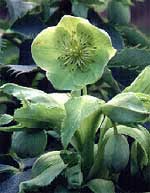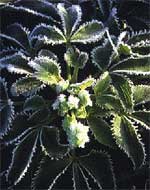

Helleborus argutifolius Viviani
Formerly known as H. corsicus (the name still lingers) its imposing stature and dramatic evergreen foliage alone demand appreciation but then its heads of pale green cups come just when we need them, in late winter and early spring. This is an adaptable plant, thriving in sun or shade and in a variety of soils while seedlings are usually produced in great quantity and germinate readily.
Description
A big, bold and statuesque plant with stout green stems reaching 3-4ft (90cm-1.2m) in height on which all the leaves are carried; there is no basal foliage. A mature plant will spread to a diameter of about 4ft (1.2m).
The leathery leaves are slightly dull, mid to pale green above and paler below with the veins on the upper surface relatively inconspicuous compared with the more striking pattern seen in its close relation H. lividus. Each leaf is divided into three leaflets which vary greatly in size according to the age of the plant and the luxuriance of its growth, but generally in the range 5-7in (12.5-17.5cm) long and about 2in (5cm) across. The central leaflet is usually straight and the outer two, as Christopher Lloyd puts it, 'pouched on their lower side like a pelican's bill'. This is stylish way of saying that one edge is longer than the other. The leaf margins are coarsely spined.
The stems broaden slightly at the point where the flowering shoot emerges from the stem to carry a head of 20-30 flowers; flowering usually starts in January and lasts until March or April. The flowers are regular, with a rounded cup shape which opens out slightly as the flowers age and are a uniform pale green in colour and 1-2in (2.5-5cm) across. The nectaries are green and the stamens curve outwards as they mature, eventually bending through a semi-circle; the styles bend outwards in the same way in the bud stage, then stand straight by the time the flower opens and they are ready to receive pollen.
Any plant showing signs of pink colouring on the stems or the backs of the leaves was always thought to be a hybrid with H. lividus but this must be reconsidered since recently collected seed from Corsica has produced both pink tinted and plain green seedlings. Seed distributed by the Hardy Plant Society as 'red flushed form' yielded plants no more than a quarter of which showed a pink tint and then only a faint one, never as red as the dark flush shown in H. foetidus 'Wester Flisk'. They showed no evidence of hybridisation with H. lividus.
This is an unmistakeable plant. Its stout stems, sharply spined leaves and large heads of apple green flowers mark it apart from all other hellebores and although closely related to H. lividus botanically, there is little chance of confusion.
Natural distribution and habitat
In the wild H. argutifolius is confined to two Mediterranean islands, Corsica and Sardinia, where it is widespread and in Corsica in particular it can be found all over the island. It is perhaps strange that it has never been found in Italy or France, the two nearest mainland countries to these islands and only 28 miles (45km) away, while its only close relation, H. lividus, grows on Majorca which is 200 miles (320km) away.
On Corsica H. argutifolius grows in a wide variety of habitats. In some parts of the island it grows on the shore, you will see it on roadsides, in woodland, in maquis where it can reach as much as 6ft (1.8m) in height and on exposed mountain tops where specimens as small as 9in (23cm) have been found. In hillside pastures it gathers around rocks which provide a cool run for the roots and sometimes it grows in stream beds (as does H. lividus on Majorca).
Amongst its companions in these various haunts are Anemone hortensis and A. apennina, Berberis vulgaris, Corydalis solida, Crocus corsicus, Cyclamen repandum, Euphorbia characias subsp. wulfenii, Lavandula stoechas and Paeonia mascula subsp. russii - a good recipe for a garden grouping.
Cultivation
The Corsican hellebore is not a fussy plant. It is probably at its best in full sun in a rich, but well drained, slightly limy soil where it will not grow too tall and will retain its foliage low down on the stems. Full sun or partial shade will help prevent the growth of long weak stems for in shade the stems tend to become drawn and prone to collapse. Although this is less of a problem in wilder situations, the flowering heads will always turn up at the ends of the branches; in more prominent positions this is clearly a disadvantage.
But H. argutifolius is tolerant of most soils which are not parched or waterlogged. It is not happy in heavy clay but does well on chalk and can sometimes be seen thriving in relatively inhospitable spots such as cracks in dry walls and between paving stones laid on sand.
Given that heavy snowfalls can also flatten an impressive plant in one night staking plants is a wise precaution. This can be done with a stout central stake driven in close to the crown and the various stems supported individually. String tends to bite into the stems thereby encouraging them to break so old tights are usually more satisfactory. Alternatively four or five stakes or stout canes can be knocked in around the plant, again on the inside of the stems, and string or old tights run all the way round to support the stems as a group. Mature specimens produce so much heavy foliage that it makes sense not to plant in windy sites.
The fact that the stems overwinter means that the dreaded black spot disease has the benefit of an all the year round host, contentedly spreading from old to new shoots year by year. Regular spraying is necessary to deal with this, especially if you grow other more valuable hellebores which could be infected or if you wish to collect seed from your H. argutifolius. Black spot has a nasty habit of attacking the base of the old stems as seed is setting and a race develops between the ripening of the seed and the predations of the disease.
If you do not require seeds, cut the old flowering stems off at ground level as soon as their glory has faded and at the same time spray the base of the plant against black spot and repeat this a fortnight later. Remove the supports and enjoy the young shoots surging through, then replace them when the shoots have developed.
Self sown seedlings of this species are common and in good conditions will flower in their first spring; most will flower in their second unless conditions are especially poor. Removing the seedlings is advisable otherwise your original plant may become surrounded by a tangle of its offspring, and given that one plant can spread to as much as 4ft (1.2m) across, chaos is likely to be the result. This species is best set in its final position while still young so the wisest policy is to thin the seedlings to about 4in (10cm) apart then move them when they have two true leaves and plant them at once in their final sites.
This is not a long lived plant, eight or nine years is possible, five or six more common, and after four years it pays to ensure that you have seedlings coming along to act as replacements for the parent. Plants develop quickly so there will only be a short lull until you again have a mature specimen.
In gardens
Graham Thomas made a striking picture by grouping this plant with the yellow variegated Eleagnus x ebbingei 'Gilt Edge' and the red stemmed Cornus alba 'Sibirica'. This was Margery Fish's favourite hellebore and she grew it against a background of variegated privet with Cotoneaster horizontalis at its feet and white Japanese anemones for September. She suggested adding Lilium regale and Polygonatum x hybridum for earlier in the season.
This species is ideal when set amongst other Mediterraneans and it looks especially good with Euphorbia characias in any of its forms but especially perhaps in the grey-blue leaved 'Blue Hills' and also the red tinted E. x martinii. Wild purple stocks, blue rue and some of the larger cistus also make suitable neighbours and it looks stunning with wild Anemone coronaria.
The imposing stature of this plant also makes it an ideal one for growing as a specimen in paving and if you have a plant in a nearby border its tendency to self sow will soon provide you with a seedling in a suitable spot.
This species is one of the few which are good for cutting as it stands up well in water, a quality it has passed on to its hybrids. Elizabeth remembers the flowers being used at Constance Spry as they took up water well and looked stunning in bridal bouquets.
Cultivated forms
‘Little Erbert’ Dwarf form reaching only 15in/38cm in height.
‘Janet Starnes’ Foliage is speckled, sometimes very densely especially on young leaves, with gold or yellow and the shoot tips tinted in pink. 2ft/60cm high, rather variable.
‘Pacific Frost’ Foliage is speckled, sometimes very densely, with cream or white and the shoot tips tinted in red. 2ft/60cm high, rather variable, may not be genuinely distinct from ‘Janet Starnes’.
Select strain An American strain with large, much darker, almost blue foliage and a characteristic red blotch at the base of each leaf where it joins the stem. Many of the stems have red to purple stippling. 2-4ft/0.6-1.2m
‘Silver Lace’ Foliage pewtery green, but not lacy, and with gappy flowers.
There is also an especially large flowered form grows at Bodnant garden in North Wales and often wins prizes when cut for RHS competitions. This form was awarded a First Class Certificate by the RHS in March 1960. Montrose Nursery of Hillsborough, North Carolina have been developing forms which are especially hardy.
 |
|
|
|
|
 |
|
|
|